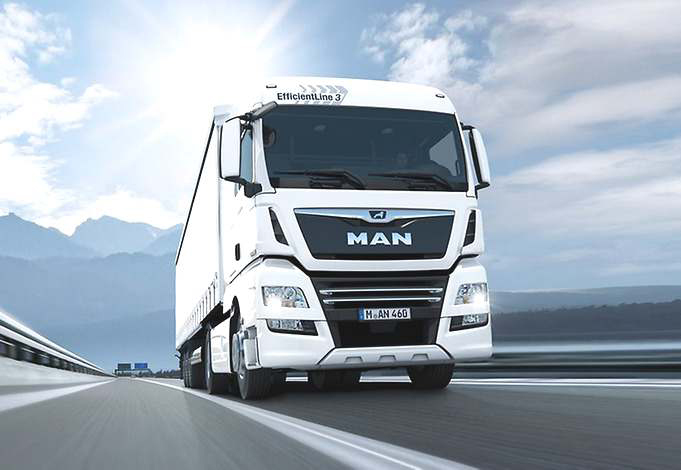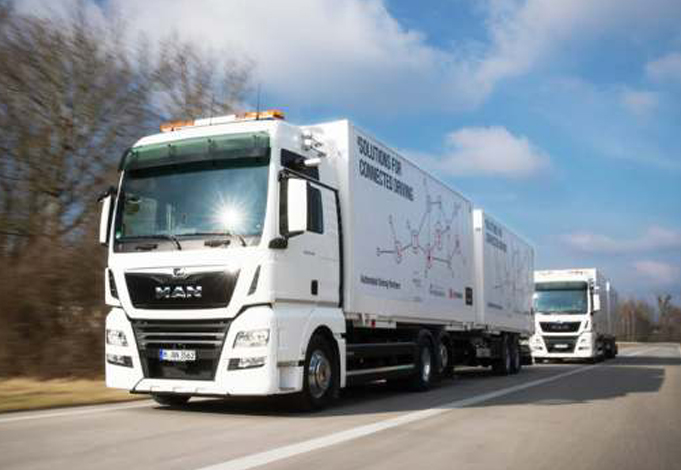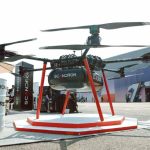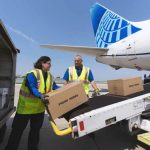Platooning in the logistics industry: Great potential in real operations after successful field test
35,000-km pilot project run by DB Schenker, MAN Truck & Bus and Fresenius University of Applied Sciences shows electronically linked trucks increases road safety and efficiency.
The participants of the platooning-project presented the research results at the final event at the Federal Ministry of Transport and Digital Infrastructure (BMVI) in Berlin (l.t.r.): Joachim Drees, MAN Truck & Bus, Alexander Doll, Deutsche Bahn, Dr. Tobias Miethaner, Federal Ministry of Transport and Digital Infrastructure, Andy Kipping, Truck Driver DB Schenker, Prof. Dr. Sabine Hammer and Prof. Dr. Christian Haas, both Hochschule Fresenius. Supplied Photo
Operating electronically linked trucks on German motor ways is safe, technically reliable and easily applicable in the routine of a logistics company, thus, we’re the findings of the world’s first field test with truck platoons in real logistics operations, which the project partners presented in Berlin recently.
Professional drivers drove two electronically linked vehicles on the Autobahn 9 between the Nuremberg and Munich branches of the logistics company DB Schenker over the course of seven months as part of the research project sponsored by the Federal Ministry of Transport and Digital Infrastructure (BMVI).
 Having covered some 35,000 test kilometers, the truck drivers, who drove at a distance of only 15 to 21 meters, praised the driving comfort and the general sense of safety . The field test also demonstrated savings in fuel consumption.
Having covered some 35,000 test kilometers, the truck drivers, who drove at a distance of only 15 to 21 meters, praised the driving comfort and the general sense of safety . The field test also demonstrated savings in fuel consumption.
The Federal Ministry of Transport and Digital Infrastructure (BMVI) contributed funding of approximately EUR1.86 million to the research project. The project partners DB Schenker, MAN Truck & Bus and the Fresenius University of Applied Sciences presented the results at the Ministry.
According to the project partners, the use of truck platoons could ensure more efficient use of space on motor ways, less congestion and increased road safety.
“The mobility of the future will be automated and networked. Of course, this is also true for logistics. I therefore fully support the industry in bringing technologies such as platooning to market maturity,” said Andreas Scheuer, Federal Minister for Transport and Digital Infrastructure.
“We want to make the processes even safer, more efficient and more environmentally friendly, all along the value chain. The drivers have a key role to play here. In a digital truck they will be modern logistics specialists. This will open up new prospects for the profession.”
Doll believes platooning possible on 40% of kilometers operated by land transport
According to DB Schenker’s research, platooning can be used extensively in the logistics network.
Alexander Doll, Member of the Management Board for Finance, Freight Transport and Logistics at Deutsche Bahn AG said, “We have analyzed our European transport network and it is safe to say that around 40% of the kilometers traveled could be carried out in platoons.” For this, however, further tests and ensuring the regulatory framework would be necessary. Customers would also benefit. “With platooning we can offer even more reliable transports.”
The platooning system installed in the MAN trucks operated smoothly 98% of the time. Active interventions by the driver were necessary only once every 2,000 kilometers, which is much less than expected. In addition, the pilot project demonstrated a 3 to 4 percent reduction in fuel consumption.
 “We were able to show that platooning has the potential to contribute to the reduction of fuel consumption and CO2 emissions. First and foremost, we are pleased that the system works reliably and can increase safety on the motor wa y . Accordingly , platooning is an important step for us on the way to automation,” said Joachim Drees, Chairman of the Management Board of MAN Truck & Bus SE.
“We were able to show that platooning has the potential to contribute to the reduction of fuel consumption and CO2 emissions. First and foremost, we are pleased that the system works reliably and can increase safety on the motor wa y . Accordingly , platooning is an important step for us on the way to automation,” said Joachim Drees, Chairman of the Management Board of MAN Truck & Bus SE.
Scientists confirm that drivers feel safe
Scientists from the Fresenius University of Applied Sciences investigated the psychosocial and neurophysiological effects on the drivers. Having experienced the actual field test brought about a significant change in the previously sceptical attitude of the drivers.
“A general sense of safety and trust in the technology is echoed in the drivers’ assessment of specific driving situations. None of the sewere described as uncontrollable,” said Professor Sabine Hammer from the Institute for the Science of Complex Systems (Institut für komplexe Systemforschung, IKS) at the Fresenius University of Applied Sciences.
The drivers experienced vehicles of other road users cutting in from adjacent lanes or cutting across multiple lanes as “disagreeable”, but not critical. “Due to the fast response times of the system, drivers would now prefer a distance of 10-15 meters,” said Hammer.
“The EEG measurements show no systematic differences between platoon runs and normal runs when it comes to the neurophysiological stress placed on drivers, i . e . in terms of concentration or fatigue,” said Professor Christian Haas, Director of the IKS. For international use, the scientists recommend further research with longer periods in platooning mode.
The project partners are convinced that the potential of truck platooning can be further increased by future developments. In addition, new digital business models in logistics are conceivable.
How platooning works
The term “platooning” refers to a system that vehicles use on the road in which at least two trucks drive in a tight convoy on a motorway, supported by technical driving assistance and control systems.
All vehicles driving in the platoon are electronically linked to each other. The truck in front sets the speed and direction, and the others follow.
Source: www.truck.man.eu.
Quick Facts: Practical operation
- Operation between DB Schenker terminals between Munich and Nuremberg (around 145 kilometers) on the digital test section of the A9 autobahn
- Time period: August until December 2018 (initially dummy cargo, followed by real cargo from the European cargo network of DB Schenker)
- Departure from Munich each time 9.30 pm, departure from Nuremberg each time 1.30 am
- Driving in platoon: average of around 73 kilometers per tripTotal kilometers driven during practical operation: 35,000
- Longest permitted platoon phase: 30 minutes
- Permitted maximum speed: 80 km/h
- Compulsory separation of platoon at freeway junctions, ahead of roadworks, on up/downgrades of over four percent as well as in especially heavy traffic; platooning not permitted on wet roads
- Fuel saving: three to four percent in the follower vehicle, 1.3 percent in the lead vehicle
- Research setting
- Scientific monitoring over 13 months by six scientists from Fresenius University
- Use of electroencephalogram (EEG) and mobile eye-tracking glasses while driving
- EEG: Derivation of voltage fluctuations at the surface of the head caused by constant electrical changes of state of brain cells; analysis of degrees of alertness and activation of each driver
- Eye-tracking: Analysis of eye movements (distribution of glances, duration of focusing, areas of interest)
- As part of the social-science investigations, open interviews with the drivers; prior to the test phases, 23 drivers in groups and the ten test drivers in individual interviews (contents: career choice, job characteristics, job rating, assumptions with regard to practicability, safety and consequences of platooning technology); after the test phase, participating drivers in individual interviews (contents: experiences, rating and possibilities for improvement of the technology); also standardized questionnaires on technology acceptance, trust in technology, subjective alertness and safety-relevant rating of specific driving situations














